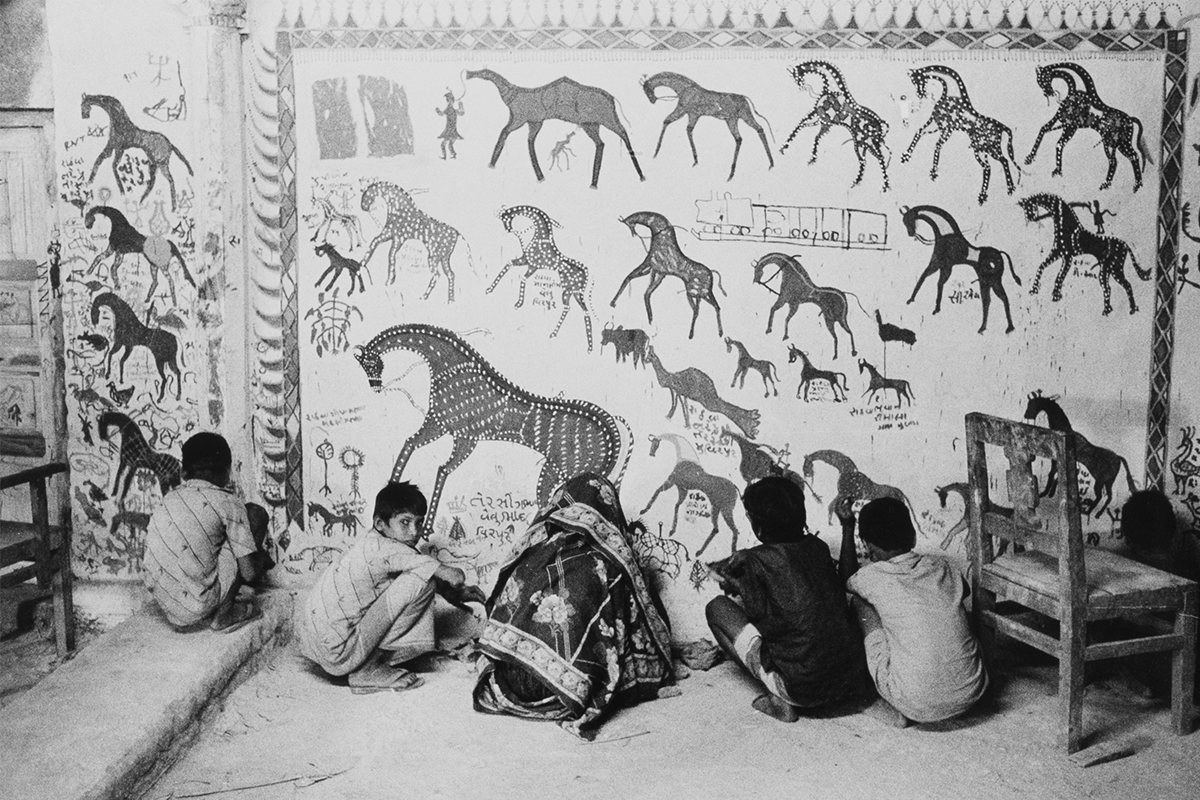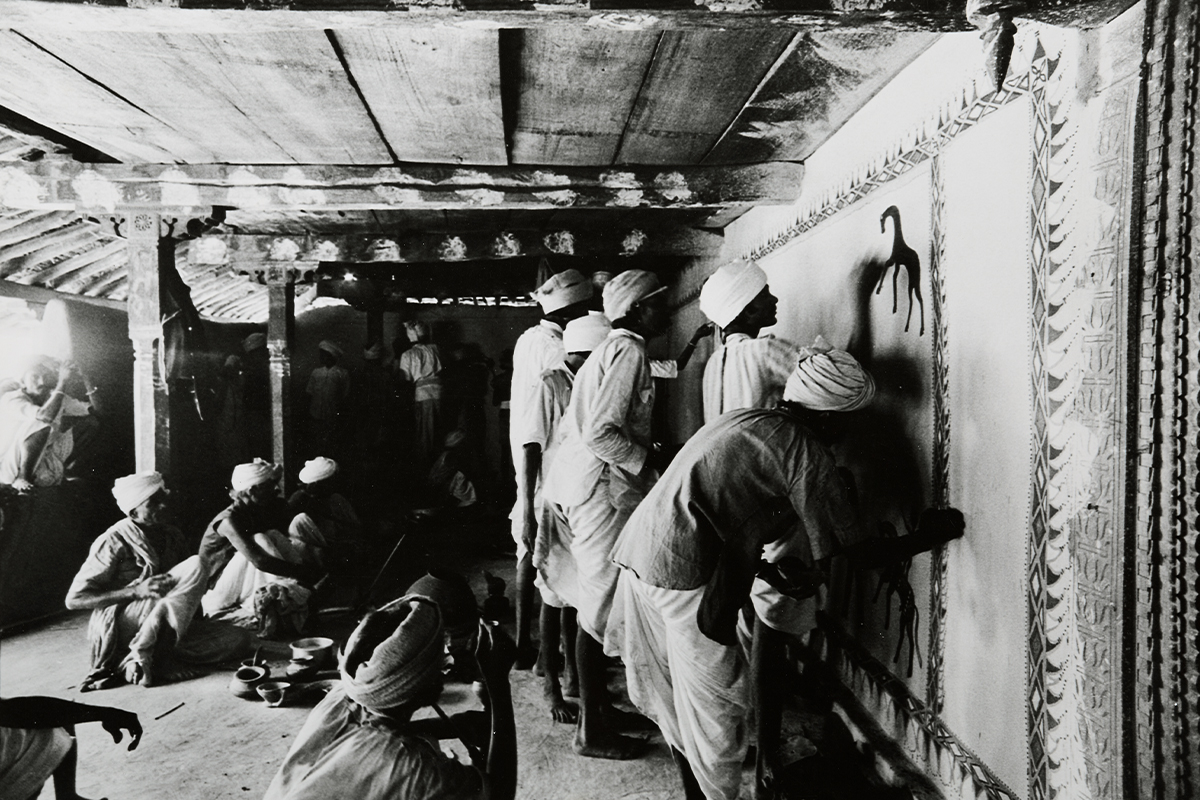ARTICLE
Pithora Painting
A mural painting tradition central to the socio-religious practices of the Rathwa, Bhil and Bhilala communities in Gujarat and Madhya Pradesh, Pithora painting derives its name from Baba Pithoro – also known as Baba Pithora or Pithoradev – one of the principal deities worshiped by these communities. The history and origins of Pithora painting, as well as the influences it has absorbed, remain a matter of debate between historians
In Gujarat, Pithora painting is practised by the Rathwa community residing in the districts of Panchmahal and Chhota Udaipur in the eastern part of the state. Within Madhya Pradesh, it is practised by the Bhil and Bhilala communities in the districts of Dhar and Jhabua, close to the state border with Gujarat.
A household facing difficult circumstances, such as financial troubles or the illness of a family member, chooses to have a Pithora painting made in their home as a way of invoking the blessings of Baba Pithoro and his maternal uncle, Baba Ind. The decision to do so is based on the advice of a badva, a community healer and a specialist in the rituals of Pithora. The badva gives the ghardani – the head of the household sponsoring the ritual – a deadline by which the painting must be completed and installed. Once the household collects the resources to organise the ritual, an invitation is sent to the lakhara artists (also known as lakhindra in Madhya Pradesh), who specialise in Pithora painting.
Traditionally, only men engage in Pithora painting and, often, members of a single family paint as a group of six to eight artists. The border is the only aspect of a Pithora painting that is considered to be ‘drawn.’ The act of painting the gods, figures, motifs and designs inside the border is considered to be an act of writing. While a badva may lead a team of lakhara, the two groups have distinct roles in the ritual: lakhara ‘write’ the pithora on the wall and it is the reading of the badva that lends it meaning and sanctity.
Pithora painting is typically done on the central wall of a home – sometimes known as the raj bhitt or royal wall – that overlooks the inner porch. The two walls on either side of the central wall may also be painted during the ritual. The season of Pithora painting begins after Diwali, in October–November. The lakhara, who are also farmers, are invited to households to paint from November to May and June, and the ritual acts as an additional source of income for them. The central wall is first prepared with a coat of white clay, traditionally applied by the unmarried women of the household. The border, called heem, is drawn out first, followed by the entrance known as jhanpo. The lakhara then draw the horses, both by hand and with the help of a stencil. The depiction of horses of an equal size is believed to be important for appeasing the deities of the painting. Once the horses are painted, the individual figures – including those of Baba Pithoro and his wife Rani Pithori as well as Baba Ind and Rani Kajal – are completed. The lakhara traditionally use brushes made of tender bamboo shoots or twigs of the Bawal tree or the Palash tree, while pigments are derived from dried plants and minerals. The powdered pigments are mixed with cow or goat’s milk and distilled mahudo, a drink made from fermented flowers of the Mahua tree that functions as a binder. Over the last few years, the lakhara in Gujarat have begun adding silver tinsel to render a sheen to the painting. While there are exceptions, work on a Pithora painting usually begins on a Monday, with the layering of the wall, and ends on a Wednesday.
There are three primary sections in a pithora: the upper realm, the marriage procession of Baba Pithoro and the third realm, which represents the gods and the community’s lives and beliefs. The first section of the wall, which represents the higher realm, features motifs depicting the sun and the moon, a chameleon and figures from the community belief system such as ektangyo (a one-legged man) and suparkanya (a wide-eared person). Hadhol, a messenger of the gods, is depicted in the top right corner of the wall. The second section, which is the central space of the painting, shows the marriage procession of Baba Pithoro and his wife Pithori Devi, also known as Pithori. The procession is shown as moving from the right to the left and the other figures featured are usually members of Baba Pithoro’s family. In the third section, figures from Rathwa mythology are depicted alongside motifs of fertility as well as motifs inspired by modern life. As a result, figures such as Abho Kunbhi and Mathari (the founders of farming), Baba Ganeh, Bara Maathya or Baara Matha no Dhani (local deities) and the sisters Lekhari and Jokhari (writers of the future) may share space with a granary, a bull, a clock, a radio or even a tube well. The jhanpo, also known as the gateway to the Pithora, is typically guarded by tigers.
There are notable differences between Pithora painting in Gujarat and Madhya Pradesh. Among the Bhil and Bhilala communities, the paintings bear similarities with rock art in their use of triangles joined at the apex to depict animal and human figures. Further, deities such as Baba Ind are depicted in the form of horses. In Rathwa, however, Pithora paintings are elaborate, highly ornamented and traditionally feature human figures and horses moving left to right in a kind of procession.
The entire ritual – of making, celebrating and consecrating a Pithora painting – is called panghu and the household invites all members of the community and individuals outside the community to attend it. The guests and the family celebrate the event, drinking, dancing and feasting while the badva conducts the rituals for the painting.
The ritual is concluded with the consecration and installation of the painting. This ceremony begins with a goat sacrifice, following which the badva begins to read the painting, naming the deities depicted in it and narrating their stories. Serving as a medium between the deities and the community, the badva – sometimes in a trance-like state – inspects the painting, asking for missing elements to be added and making predictions for the family. Once the painting has been consecrated, it is considered an important part of the household. The area around the painting is kept clean and offerings are made to the painting seasonally and on special occasions. Women are required to cover their heads before the painting and are prohibited from touching it. Depending on the type of vow taken and the resources at hand, a family may initiate the painting of an ardho pithoro (half pithora) or an akkho pithoro (full pithora). The primary difference between the two is the depiction of the number of horses and the procession. An ardho pithoro has fewer horses and the riders are not depicted in human form, while in an akkho pithoro the riders are painted in detail along with eighteen horses. Once completed, a Pithora painting is not tampered with.
Over the last few decades, Pithora painting has evolved to include the use of materials such as fabrics, paper, acrylic and poster colours. Since the 1980s, several individual artists have risen to prominence, the most renowned among them being Bhuri Bai and Pema Fatya from Madhya Pradesh. Pithora paintings are also being made for a wider audience, including museums, tourists and art collectors, and in many instances such works depict only certain segments and motifs rather than the entire painting. These developments have allowed the lakhara to gain prominence independently of the ritual, where the badva played the more important role.
Among the Rathwa community, Pithora painting has also absorbed external influences and materials, such as depictions of the Hindu god Ganesha, more elaborate borders and motifs, and the whitewashing of walls prior to painting. The Pithora painting of the Rathwa community was awarded a Geographical Indication (GI) tag by the Indian government in 2021.
Bibliography
Our website is currently undergoing maintenance and re-design, due to which we have had to take down some of our bibliographies. While these will be re-published shortly, you can request references for specific articles by writing to hellomapacademy@map-india.org.







![The façade of the Maneckji Seth Agiary, a Zoroastrian fire temple, is a standout example of the popularity of the Persian Revival Style in Western India in the 19th and 20th centuries. This style was often seen in the architectural patronage of the Parsis, who emerged as one of the most influential mercantile communities of British India. Popular motifs of this style, like the mythical lamasus (winged bulls with human heads) and the faravahar (a winged guardian spirit in Zoroastrianism), drew on the historical art and architecture of the Achaemenid and Sasanian empires from sites like Persepolis, Bisotun, Taq-e Bostan, Naqsh-e Rostam and Naqsh-e Rajab in Persia.
The Parsi community’s adoption of this style occurred largely due to their networks of global commerce and politics, allowing them to access and translate research of ancient Persia into visible symbols that underlined their association with antiquity, imperial power, and art.
نمای آتشکدهی زرتشتی مانِکجی سِت نمونهی بارزی از رواج سبک «احیای [معماری] ایرانی» در غرب هند طی سدههای نوزدهم و بیستم است. این سبک غالباً در بناهایی دیده میشد که پارسیان، از بانفوذترین جوامع بازرگان در هند بریتانیا، بانیشان بودند. نقشمایههای محبوب این سبک، مانند گاو بالدار اساطیری (لاماسو) و فَروَهَر (روح بالدار نگهبان در دین زرتشت)، برگرفته از هنر و معماری شاهنشاهی هخامنشی و ساسانی، در جاهایی چون تخت جمشید و بیستون و طاق بستان و نقش رستم و نقش رجب، بود.
اقتباس جامعهی پارسیان از این سبک بسیار مرهون روابط گستردهی تجاری و سیاسی آنها بود که دسترس به پژوهشها دربارهی ایران باستان و برگردانیدن آنها به نمادهای بصری را ممکن میکرد و بر پیوند پارسیان با دوران باستان و قدرت شاهنشاهی و هنر تأکید میکرد.](https://mapacademy.io/wp-content/plugins/instagram-feed/img/placeholder.png)
